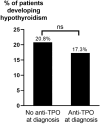Thyroid peroxidase antibodies and their role in predicting outcomes in Graves' disease treatment
- PMID: 40255503
- PMCID: PMC12006005
- DOI: 10.3389/fendo.2025.1517283
Thyroid peroxidase antibodies and their role in predicting outcomes in Graves' disease treatment
Abstract
Introduction: Graves´ disease (GD) is the predominant cause of hyperthyroidism. Treatment options include antithyroid drugs (ATD), surgery, and radioactive iodine ablation (RI). Although thyroid peroxidase antibodies (anti-TPO) are prevalent in patients with GD, their role in driving relapse or hypothyroidism after treatment in patients with GD remains unclear. This study aimed to determine if patients with anti-TPO at GD diagnosis are more likely to relapse after ATD or RI treatment, and if patients with anti-TPO are at increased risk of developing hypothyroidism post-ATD treatment.
Methods: This was an observational, non-interventional retrospective registry study, which included 712 patients treated for GD at a single center in Sweden during 2002-2018.
Results: After therapy with ATD, there was no difference in relapse rate between patients with (37.0%) or without (38.4%) anti-TPO at GD diagnosis. Age <40 years was a risk factor for relapse after ATD (p<0.0001). Presence of anti-TPO at diagnosis was associated with reduced relapse rate after RI (13.9% vs. 24.6%; p=0.049). Development of hypothyroidism after discontinuation of ATD did not correlate with anti-TPO status at diagnosis (with anti-TPO: 17.3%; without anti-TPO: 20.8%). Increased risk of hypothyroidism was seen with ATD treatment for >2 years, p<0.05.
Conclusion: Anti-TPO positivity at diagnosis of GD did not affect the relapse rate after ATD treatment but could be associated with a better long-term effect of RI. Anti-TPO did not increase the risk of hypothyroidism post-ATD therapy. Understanding risk factors of relapse or hypothyroidism can facilitate treatment choices and help physicians individualize management and follow-up strategies for patients with GD.
Keywords: Graves’ disease; antithyroid drugs (ATD); hyperthyroidism (Graves’ disease); long-term follow-up; radioiodine; recurrence; relapse; remission.
Copyright © 2025 Gewert, Topi, Planck and Calissendorff.
Conflict of interest statement
The authors declare that the research was conducted in the absence of any commercial or financial relationships that could be construed as a potential conflict of interest.
Figures




Similar articles
-
Changes in Thyroid Peroxidase and Thyroglobulin Antibodies Might Be Associated with Graves' Disease Relapse after Antithyroid Drug Therapy.Endocrinol Metab (Seoul). 2019 Sep;34(3):268-274. doi: 10.3803/EnM.2019.34.3.268. Endocrinol Metab (Seoul). 2019. PMID: 31565879 Free PMC article.
-
The Long-Term Outcome of Treatment for Graves' Hyperthyroidism.Thyroid. 2019 Nov;29(11):1545-1557. doi: 10.1089/thy.2019.0085. Thyroid. 2019. PMID: 31482765 Clinical Trial.
-
Efficacy of Anti-Thyroid Medications in Patients with Graves' Disease.BMC Endocr Disord. 2024 Sep 6;24(1):180. doi: 10.1186/s12902-024-01707-0. BMC Endocr Disord. 2024. PMID: 39237901 Free PMC article.
-
Risk Factors for the Relapse of Graves' Disease Treated With Antithyroid Drugs: A Systematic Review and Meta-analysis.Clin Ther. 2020 Apr;42(4):662-675.e4. doi: 10.1016/j.clinthera.2020.01.022. Epub 2020 Mar 2. Clin Ther. 2020. PMID: 32139177
-
Graves' Disease: Can It Be Cured?Endocrinol Metab (Seoul). 2019 Mar;34(1):29-38. doi: 10.3803/EnM.2019.34.1.29. Endocrinol Metab (Seoul). 2019. PMID: 30912336 Free PMC article. Review.
References
-
- Ferrari SM, Fallahi P, Ruffilli I, Elia G, Ragusa F, Benvenga S, et al. . The association of other autoimmune diseases in patients with Graves’ disease (with or without ophthalmopathy): review of the literature and report of a large series. Autoimmun Rev. (2019) 18:287–92. doi: 10.1016/j.autrev.2018.10.001 - DOI - PubMed
Publication types
MeSH terms
Substances
LinkOut - more resources
Full Text Sources
Research Materials

